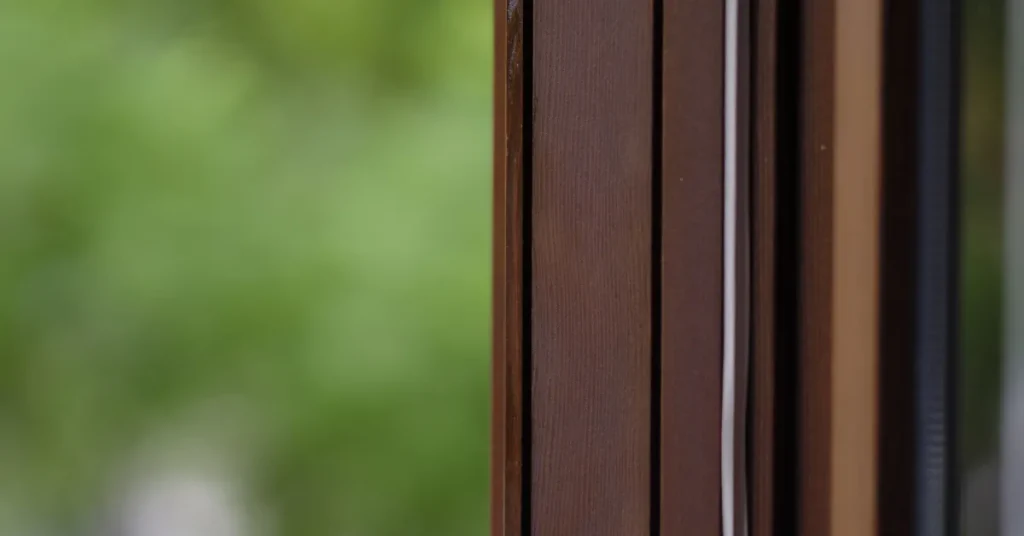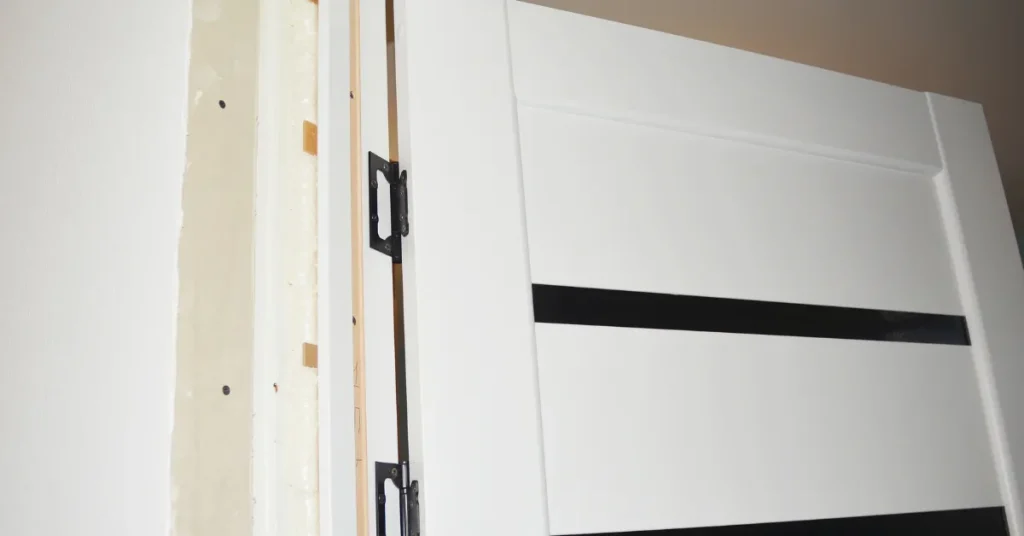A standard door jamb is approximately 4 9/16 inches thick. This thickness can vary depending on the wall thickness and door size.
Exploring the structural components of a home can be essential for both renovation and construction projects. The door jamb is a crucial element in the anatomy of a door, as it provides the frame to which the door is secured.
Typically made of wood or steel, door jambs must offer stability and durability to withstand daily usage. Their thickness is designed to match the breadth of the wall’s stud and drywall assembly, ensuring a seamless and supportive fit.
Contractors and DIY enthusiasts should measure the existing structure or consult building codes to ensure the correct jamb thickness for optimal door function and aesthetic coherence.
Understanding this, homeowners can make informed decisions when selecting doors for new installations or replacements, ensuring longevity and ease of use.

Introduction To Door Jambs
Welcome to the world of door jambs, the unsung heroes of door installations! Often overlooked, door jambs play a pivotal role in the functionality and security of any door.
Let’s delve into what makes a door jamb not just a structural element, but a key player in the door’s performance.
Essential Role In Door Installations
Door jambs are fundamental in making sure doors open and close smoothly. They are the vertical supports around which a door swings. Proper installation ensures that a door is level, secured, and has a reliable frame to latch onto.
Moreover, it’s the jamb’s thickness that aids in defining the durability and strength of your door setup.
Variety In Types And Uses
Diverse in makeup, door jambs cater to various needs and functions. They come in different materials, such as wood, steel, or composite, each suitable for different environments.
Their thickness can vary, usually between 4 9/16 inches to 7 1/2 inches, depending on wall thickness and installation standards.
- Standard Residential Jambs: Typically 4 9/16 inches to accommodate most homes.
- Commercial Jambs: Thicker, often up to 7 1/2 inches for added security and durability.
- Custom Jambs: Designed to fit unique doorways or specialized architectural requirements.
Measuring Door Jamb Thickness
Understanding the thickness of a door jamb is vital for installation, replacement, and even security purposes.
Measuring the thickness correctly ensures a snug, efficient fit for any door. Let’s walk through the easy-to-follow steps for accurately gauging the size of your door jamb.
Tools For Accurate Measurement
To start off, the right tools are essential for precision. Gather these instruments:
- Tape measure: Your go-to tool for measuring lengths.
- Straight edge or carpenter’s square: Ensures straight lines for consistency.
- Notepad and pencil: Keep your measurements handy.
Step-by-step Guide
- Open the Door: Ensure full access to the jamb.
- Position Your Tape Measure: Place it at the edge of the door jamb.
- Extend the Tape Measure: Pull it across to the opposite edge.
- Use the Straight Edge: This guarantees an accurate line for measuring.
- Read the Measurement: Note the number where the tape intersects the edge.
- Write It Down: Jot the figure on your notepad to remember it.
Your door jamb thickness is now accurately measured!
Standard Dimensions Across Regions

When installing a door, knowing the thickness of a door jamb is crucial. It provides the structure and support for your door. Different regions follow various standards. So let’s take a closer look.
Common Thickness In The United States
Door jambs in the US share common measurements. Most interior door jambs are 4-5/8 inches thick. This fits with typical 2×4 wall construction and half-inch drywall on both sides.
Exterior door jambs are often thicker, starting at 5-1/2 inches. This extra thickness supports larger doors and withstands more stress.
Interior Door Jambs:
– Usually 4-5/8 inches thick
– Suited for 2×4 walls
Exterior Door Jambs:
– Start at 5-1/2 inches thick
– Provide more support
International Sizes Comparison
Different countries have different construction styles. Hence, door jamb thicknesses may vary. A table below lists the typical thicknesses observed internationally:
| Country | Interior Door Jamb | Exterior Door Jamb |
| United Kingdom | 4-7/8 inches | 6-3/8 inches |
| Australia | 4-1/8 inches | 5-7/8 inches |
| Canada | 4-5/8 inches | 5-1/2 inches |
| Europe | 4-1/2 inches | 5-1/4 inches |
These dimensions ensure doors fit securely and function optimally in residential and commercial spaces.
Factors Influencing Jamb Thickness
Understanding Factors Influencing Jamb Thickness is crucial for proper door installation. The jamb is the vertical component that forms the side of the door frame. Its thickness ensures the door fits snugly and functions correctly.
Several factors will determine the precise thickness of a door jamb, ranging from the door type to local building regulations.
Door Type And Material
The door’s composition impacts jamb thickness. For example:
- Interior doors usually have thinner jambs compared to exterior doors.
- Exterior doors require thicker, more durable jambs for added security and insulation.
- Materials like solid wood may need a more robust frame than lighter options, such as composite materials.
Building Codes And Regulations
Local building codes set specific requirements for jamb thickness:
- Codes may vary depending on location and building type.
- Regulations often stipulate minimum thickness levels for safety and energy efficiency standards.
- Following these standards ensures compliance with safety and construction quality.
Custom Vs. Standard Sizing
Choosing the right door jamb thickness is crucial for door installation. Both custom and standard sizing play vital roles. Homeowners and builders must understand their differences. This will ensure a perfect fit and function for any door setup.
When Customization Is Necessary
Custom door jambs cater to unique design needs. Think about these instances:
- Irregular wall thickness
- Historic home renovations
- Unique door designs
They provide a perfect fit where standard sizes won’t work.
Pros And Cons Of Going Custom
Custom door jambs have advantages and drawbacks.
| Pros | Cons |
| Tailored fitUnique design optionsAdjustments for wall thickness | Higher costsLonger production timeComplex installation |
Balance the benefits against the potential drawbacks. This will help make an informed decision.
Installation Tips For Optimal Fit

Installation Tips for Optimal Fit can make or break the functionality of your door. The thickness of a door jamb plays a crucial role in the stability and performance of your door.
Getting it right involves careful preparation of the doorway and ensuring the structural integrity of the frame. Follow these installation tips to ensure your door jamb fits perfectly within your home’s structure.
Preparing The Doorway
Before you start, measure the thickness of your existing door jamb or the space where the new one will go. This will guide you in purchasing the correct size. Next, clear the doorway.
- Remove any debris.
- Check the floor for levelness.
- Trim the area if necessary for a flush fit.
Be sure the space is clean and free from obstructions that might cause issues during installation.
Ensuring Structural Integrity
The door jamb supports the weight of your door, so it must be strong. Here’s what to do:
- Inspect the surrounding walls.
- Look for cracks or weaknesses.
- Reinforce with additional framing if required.
Ensure the door jamb fits snugly and securely, as this affects the door’s operation and safety. Be sure to address any potential structural concerns before installing the new jamb.
FAQs About How Thick Is A Door Jamb
Is My Door Jamb 2×4 Or 2×6?
To determine whether your door jamb is 2×4 or 2×6, measure the width of it. A 2×4 jamb is approximately 3. 5 inches wide, while a 2×6 measures about 5. 5 inches.
How Thick Is A Door Frame In Inches?
A typical door frame is about 4 to 9 inches thick, depending on wall thickness and construction standards.
Does Door Jamb Size Matter?
Yes, door jamb size is important as it must match the thickness of the wall and accommodate the door width for proper installation and function.
How Wide Is The Kerf On A Door Jamb?
The kerf on a door jamb typically measures about 1/8 inch wide. This allows for a snug fit for the weather stripping.
Conclusion
Understanding the thickness of a door jamb is crucial for installation and repair projects. Standard dimensions hover around 4-9/16 inches, catering to common wall sizes.
Always verify measurements, as custom options can vary. For your next home improvement endeavor, remember: accurate jamb specs are the foundation of a seamless fit.
Resources:
1. https://basc.pnnl.gov/resource-guides/air-sealing-window-and-door-rough-openings
